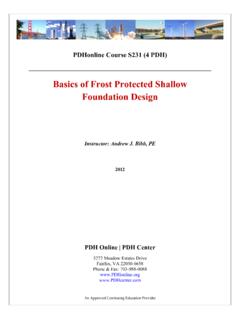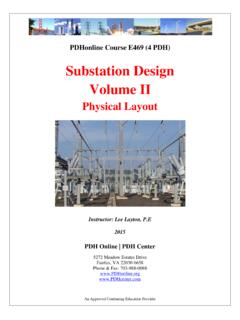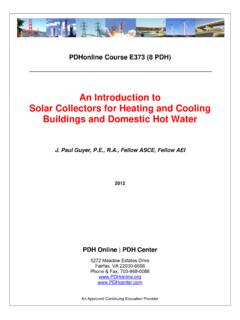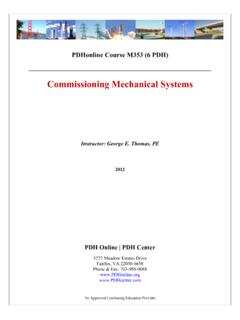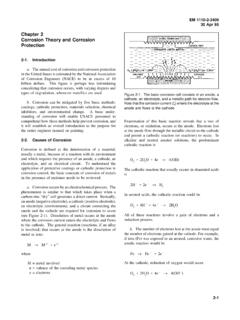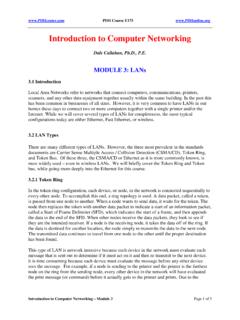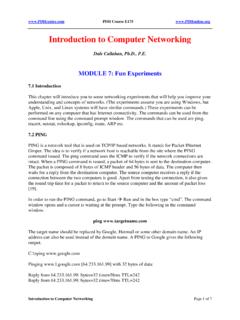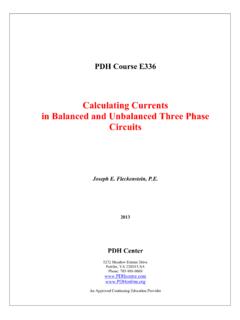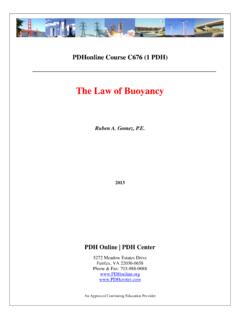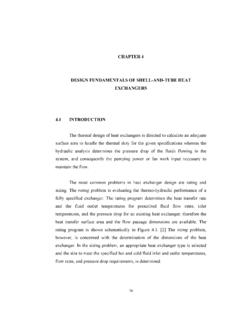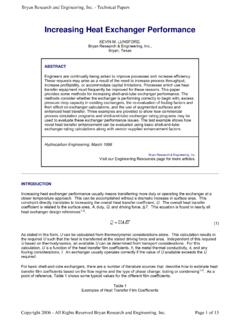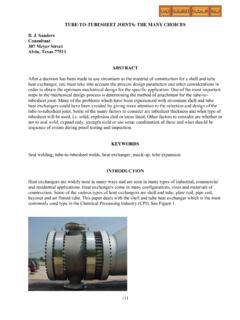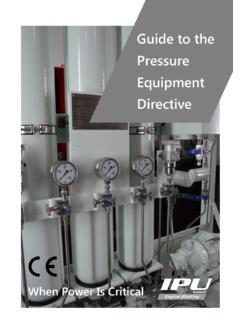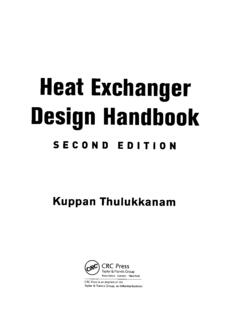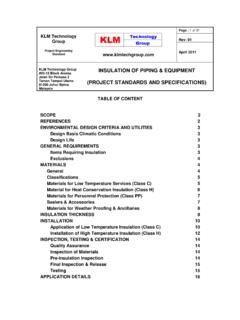Transcription of PDHonline Course M371 (2 PDH) Shell and Tube Heat ...
1 PDHonline Course M371 (2 PDH). _____. Shell and tube heat Exchangers Basic Calculations Jurandir Primo, PE. 2012. PDH Online | PDH Center 5272 Meadow Estates Drive Fairfax, VA 22030-6658. Phone & Fax: 703-988-0088. An Approved Continuing Education Provider PDH Course M371 INTRODUCTION: In intercoolers, boilers, pre-heaters and condensers inside power plants as well as other engineering processes, heat exchangers are utilized for controlling heat energy. heat exchangers are devices that regulate efficient heat transfer from one fluid to another. There are two main types of heat exchangers. The first type of a heat exchanger is called the recuperative type, in which heat are exchanged on either side of a dividing wall by fluids;. The second type is regenerative type, in which hot and cold fluids are in the same space which contain a matrix of materials which work alternately as source for heat flow.
2 The optimum thermal design of a Shell and tube heat exchanger involves the consideration of many interacting design parameters which can be summarized as follows: Process: 1. Process fluid assignments to Shell side or tube side. 2. Selection of stream temperature specifications. 3. Setting Shell side and tube side pressure drop design limits. 4. Setting Shell side and tube side velocity limits. 5. Selection of heat transfer models and fouling coefficients for Shell side and tube side. Mechanical: 1. Selection of heat exchanger TEMA layout and number of passes. 2. Specification of tube parameters - size, layout, pitch and material. 3. Setting upper and lower design limits on tube length. 4. Specification of Shell side parameters materials, baffles cut, baffle spacing and clearances. 5. Setting upper and lower design limits on Shell diameter, baffle cut and baffle spacing.
3 2010 Jurandir Primo Page 2 of 35. PDH Course M371 CONCEPTS: The biggest problem in thermodynamics is to learn and recognize heat , work, force, energy, pow- er and other technical terms. So to facilitate the basic comprehension of the terms used for Shell and tube heat exchangers calculations it is very important to remember some concepts below: Unit Multiply To Obtain 1 Btu J. kJ. kcal 1 cal J. Btu 1 kcal 1000 cal Btu Joule - energy exerted by the force of one Newton acting to move an object through a distance of 1 m. Unit Multiply To Obtain 1J kJ. cal kcal Btu Watt metrical unit for power. Unit Multiply To obtain 1W kW. hp hp (boiler). kcal/s Btu/s ton (refrig). Cal: The Cal is the standard unit of measurement for heat . The gram calorie, small calorie or calorie (cal) is the amount of energy required to raise the temperature of one gram of water from C to C under standard atmospheric pressure of Kg/cm ( psi).
4 2010 Jurandir Primo Page 3 of 35. PDH Course M371 Btu - British Thermal Unit: The Btu is the standard unit of measurement for heat . A Btu is defined as the amount of energy needed to raise the temperature of one pound of water from F to F under standard pressure of 30 inches of mercury ( psi). Obs.: To develop calculations there are several softwares and rating packages available, including the Codeware, Compress, Aspen BJAC and CC-THERM, which enable the designer to study the effects of the many interacting design parameters and achieve an optimum thermal design . These packages are supported by extensive component physical property databases and thermodynamic models. Temperature: Celsius: Is a temperature scale (also known as centigrade) that is named after the Swedish astrono- mer Anders Celsius (1701 1744), who developed a similar temperature scale two years before his death.
5 Then nominally, 0 C was defined as the freezing point of water and 100 C was defined as the boiling point of water, both at a pressure of one standard atmosphere ( Kg/cm ). Fahrenheit: Is the temperature scale proposed in 1724 by, and named after, the physicist Daniel Ga- briel Fahrenheit (1686 1736). On the Fahrenheit scale, the freezing point of water was 32 degrees Fahrenheit ( F) and the boiling point 212 F at standard atmospheric pressure ( psi). Kelvin: Is a scale that was named after the Scottish physicist William Thomson (1824 - 1907), 1st Baron Kelvin described about the need for an "absolute thermometric scale". The Kelvin and Celsius are often used together, as they have the same interval, and 0 Kelvin is = degrees Celsius. Co = 5 (Fo 32) =. 9. F = (Fo + 32) =. o Co = Ko 273 =. Pressure: Pressure (P): Is the force per unit area applied in a direction perpendicular to the surface of an object.
6 Gauge pressure is the pressure relative to the local atmospheric or ambient pressure. Unit Pascal bar atmosphere Torr pound per square (Pa) (bar) (atm) (Torr) inch (psi). 1 Pa 1 N/m 1 bar 100000 106 dyn/cm2 750 1 at 98066 1 atm 101325 1 atm 760 1 torr 1 mmHg 1 psi 1 lbf/in . 2010 Jurandir Primo Page 4 of 35. PDH Course M371 Energy Unit Conversions: Unit Multiply To Obtain Ton (refrig). 1 Btu/s kW. hp Joule/kilogram/ C = J/(kg. C). 1 joule/kilogram/K = J/( ) = Joule/gram/ C = J/(g. C)]. kilojoule/kilogram/ C = kJ/(kg. C). 1 joule/kilogram/ C = J/(kg. C) Calorie /gram/ C = cal/(g. C). kilocalorie /kilogram/ C = kcal/(kg. C). kilocalorie /kilogram/K = kcal/( ). kilogram-force meter/kilogram/K. Btu/pound/ F = Btu/(lb. F). Btu/pound/ C = Btu/(lb. C). kilocalorie /kilogram/ C = kcal/(kg. C). 1 Btu/pound/ F = Btu/(lb F) Btu/pound/ C = Btu/(lb.)
7 C). joule/kilogram/K = J/( ). joule/kilogram/ C = J/(kg. C). joule/gram/ C = J/(g. C). kilojoule/kilogram/K = kJ/( ). kilojoule/kilogram/ C = kJ/(kg. C). R. BASIC CONCEPT OF SPECIFIC heat : Specific heat : Is defined as the amount of heat energy needed to raise 1 gram of a substance 1 C in temperature, or, the amount of energy needed to raise one pound of a substance 1 F in temperature. Q = (T 2 T1). Where: Q = heat energy (Joules) (Btu);. m = mass of the substance (kilograms) (pounds);. Cp = specific heat of the substance (J/kg C) (Btu/pound/ F);. (T2 T1) = is the change in temperature ( C) ( F). The higher the specific heat , the more energy is required to cause a change in temperature. Substanc- es with higher specific heats require more of heat energy to lower temperature than do substances with a low specific heat .
8 2010 Jurandir Primo Page 5 of 35. PDH Course M371 Example 1: Using metric units and imperial units, how much energy is required to heat 350 grams ( pounds) of gold from 10 C (50 F) to 50 C (122 F)? Mass = 350g = Kg = lb Specific heat of gold = J/(g. C) = 129 J/(Kg. C) x = Btu/(lb. F). Q = (T 2 T1) =. Metric Units: Q = ( Kg) (129 J/(Kg. C) (50 C - 10 C) =. Q = 1806 J. Conversion: 1806 joules x = Btu Evaluation in Btu : Q = (T 2 T1) =. Imperial Units: Q = ( lb) ( Btu/(lb. F) (122 F - 50 F) =. Q = Btu Consult (to convert energy units): 2010 Jurandir Primo Page 6 of 35. PDH Course M371 Some samples of specific heat values are presented in the table below: Specific heat Capacity - Cp Product (J/ g C) (Btu/lb oF). Alcohol, ethyl 32oF (ethanol) o Ammonia, 104 F Castor Oil Dowtherm Freon R-12 saturated 0oF Fuel Oil max.))
9 Gasoline Heptane Kerosene Gold Light Oil, 60oF o Light Oil, 300 F Mercury Octane Oil, mineral Olive oil Petroleum Propane, 32oF Propylene Glycol Sodium chloride Soya bean oil Toluene Water, fresh 1. Water, sea 36oF heat EXCHANGERS CALCULATIONS: The main basic heat exchanger equation is: Q = U x A x T m =. The log mean temperature difference Tm is: T m = (T 1 t2) (T 2 t1) = F. ln (T 1 t2). (T 2 t1). Where: T1 = Inlet tube side fluid temperature;. t2 = Outlet Shell side fluid temperature;. 2010 Jurandir Primo Page 7 of 35. PDH Course M371 T2 = Outlet tube side fluid temperature;. t1 = Inlet Shell side fluid temperature. Note: When used as a design equation to calculate the required heat transfer surface area, the equa- tion can be rearranged to become: A = Q/ (U x T m) =. Where: A = heat transfer area (m ) (ft ).
10 Q = heat transfer rate (kJ/h) (Btu\h);. U = Overall heat transfer coefficient ( . C) (Btu/h F);. T m = Log mean temperature difference ( C) ( F). And: Ct = Liquid specific heat , tube side (kJ/kg K) (Btu/lb F);. Cs = Liquid specific heat , Shell side (kJ/kg K) (Btu/lb F). The Overall design Process: Here is a set of steps for the process. design of a heat exchanger is an iterative (trial & error) process: Calculate the required heat transfer rate, Q, in Btu/hr from specified information about fluid flow rates and temperatures. Make an initial estimate of the overall heat transfer coefficient, U, based on the fluids involved. Calculate the log mean temperature difference, Tm , from the inlet and outlet temperatures of the two fluids. Calculate the estimated heat transfer area required, using: A = Q/(U Tm ).

